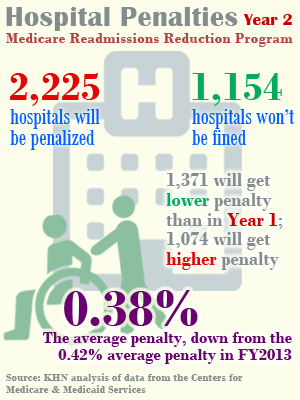Medicare will levy $227 million in fines against hospitals in every state but one for the second round of the government’s campaign to reduce the number of patients readmitted within a month, according to federal records released Friday.

Medicare identified 2,225 hospitals that will have payments reduced for a year starting on Oct. 1. Eighteen hospitals will lose 2 percent, the maximum possible and double the current top penalty. Another 154 will lose 1 percent or more of every payment for a patient stay, the records show. Hospitals that treated large number of low income patients were more likely to be penalized than those treating the fewest impoverished people.
The penalty program, which began in October 2012, is among the toughest of Medicare’s efforts to pay hospitals for the quality of their performances rather than merely the number of patients they treat. Unlike other new programs created by the federal health law, the readmissions program offers hospitals no rewards for improvements or the opportunity to opt out.
While the overall number of penalized hospitals stayed about the same — with Medicare penalizing two-thirds of eligible hospitals — there have been considerable shifts among facilities. A Kaiser Health News analysis found that 1,371 hospitals are receiving a lower fine. Alegent Creighton Health Midlands Hospital in Papillion, Neb., will see the biggest penalty decrease, going from the maximum 1 percent fine in the current year to no fine for the second year. Nationwide, the average hospital fine will be slightly smaller, and the national total will be $53 million less than this year’s fines.
Medicare is increasing penalties for 1,074 hospitals. A total of 283 hospitals not fined in the current year, including Stanford Hospital in California and Johns Hopkins’ Sibley Memorial Hospital in Washington, D.C., will be penalized in the new round.
The October penalties will be applied on at least four out of five hospitals in Alabama, Arkansas, Florida, Kentucky, Illinois, Massachusetts, New York, New Jersey, Tennessee, West Virginia and the District of Columbia, the KHN analysis found. Maryland, which Medicare exempted from the program because it has a unique reimbursement system designed under a federal waiver, is the only state without a hospital getting a fine.
“The recognition of just how complex and difficult of a problem this is is growing as people are starting to grapple with it on the ground,” said Dr. Karen Joynt, a Boston cardiologist and Harvard researcher. “It’s going to take creativity and innovation and most importantly reaching outside the hospital walls.”
Fighting Incentives To Do More
Medicare has credited the penalty program for combatting a perverse financial incentive: hospitals earn more money if their patients’ health deteriorates after they are discharged, because they can be paid for two stays instead of one. The Medicare Payment Advisory Commission (MedPAC), which reports to Congress, has estimated that 12 percent of Medicare patients may be readmitted for potentially avoidable reasons. Averting one out of every 10 of those returns could save Medicare $1 billion, MedPAC says.
The penalties are based on readmissions of Medicare patients who originally went into the hospital with at least one of three conditions—heart attack, heart failure and pneumonia—and were discharged between July 2009 and June 2012. Those that ended up in any hospital within 30 days were counted unless that readmission had been planned when the patients left the hospital after their original stay. Hospitals that had more readmissions than Medicare predicted after taking the severity of their patients’ illness into account received fines.
Nationally, the average fine decreased from 0.42 percent in the first year of the program to 0.38 percent.
In addition, 141 hospitals that in the first year were given the maximum penalty will get a lower punishment starting in October. Medicare determined that 1,154 hospitals kept their readmissions numbers low enough to escape fines.
Some of the changes in the new penalties may be due to refinements Medicare made in the way it calculated readmissions. This time, it excluded from its analyses cases where doctors had planned for a second admission. A lung cancer patient, for instance, might be admitted for pneumonia and then return for previously planned chemotherapy. Or doctors might unblock one of a heart attack patient’s arteries and have him come back for a heart pump or previously planned transplant. Medicare estimates that rehospitalizations are planned in 12 percent of heart attack return cases, 6 percent of heart failure return cases and 4 percent of pneumonia return cases.
Nationally, the rate of all readmissions dropped somewhat last winter, according to Medicare, but those changes are too recent to be reflected in this year’s penalties.
As they did last year, the Medicare penalties appeared to land harder on hospitals that treat large numbers of poor people, according to calculations Medicare made and included in a regulation published Friday.
Among the safety net hospitals with the most poor patients, 77 percent were penalized, while only 36 percent of the hospitals with the fewest poor patients were penalized. Denver Health Medical Center, which has historically had low readmission rates and thus has been cited as proof that safety net hospitals can avoid readmissions for their patients, will get a 0.04 percent penalty after avoiding any punishment last year.
However, Medicare stated that it did not see a need to take the socio-economic populations of hospitals into account in the penalties, since it already factored in the differing health of those populations. “We routinely monitor the impact of socioeconomic status on hospitals’ results and have consistently found that hospitals that care for large proportions of patients of low socioeconomic status are capable of performing well on our measures,” the agency wrote in its rule.
Dr. Eric Coleman, a director of care transitions program at University of Colorado, said more hospitals are taking readmissions seriously, in part because of the penalties. “People are starting to recognize that renaming discharge planning does not actually improve your readmissions rate,” said Coleman, who designed a widely adopted method to reduce readmissions by coaching patients on what they need to do to stay healthy after leaving the hospital. “Hospitals have moved past ‘is this for real’ or ‘should we do something.'”
Because Medicare applies the penalties to every payment for a patient stay, hospitals can only estimate what the dollar amount of the fines will turn out to be. Some large hospitals may end up losing more than $1 million from the penalties if last year is any guide.
But hospitals that succeed in reducing readmissions may end up with even less revenue by forgoing those second patient admissions, said Erik Johnson, a senior vice president at Avalere Health, a Washington consultant group that advises hospitals and other providers. “The economics of it still do not make a tremendous amount of sense, honestly,” he said. “I think hospitals are being good actors in trying to bring these numbers down.”
Hospitals Raise Concerns
The uneven impact of the penalties has been a major concern for hospitals. Low-income patients often have a harder time adhering to their post-hospital instructions, researchers say. Buying medicines can be prohibitively expensive for them, discharge instructions harder to follow, and a low-salt diet required to avoid continued congestive heart failure can be expensive. Some hospitals have noted that they have low mortality rates and said that may in part be due to their aggressiveness in recalling patients who seem to not be healing.

The hospital industry has been vocal in its dislike of the penalties, complaining that it should not be punished for patients’ health beyond the confines of the hospitals, especially since they get no extra payments for that care. The architects of the health law believed that hospitals have abdicated too much responsibility for their patients and included the penalties to force medical providers to do a better job of working together as patients move to different sites of care.
Even before the penalties kicked in last October, many hospitals started searching for better ways to ensure their patients did not relapse. Some began sending nurses to check in on patients at their homes, while others gave low-income patients free medications on their way out. Medicare does not pay hospitals for those efforts.
“In the past, hospitals haven’t been in engaged because frankly that was the responsibility of the physician or the post-acute providers,” said Chip Kahn, president of the Federation of American Hospitals, an association of for-profit institutions. “That wasn’t perceived to be part of the hospital role. Now there’s a provider who is looking over everyone’s shoulder post hospitalization to encourage compliance and appropriate service.”
Joynt and Dr. Ashish Jha, a fellow researcher at the Harvard School of Public Health, have questioned whether some safety net hospitals with limited finances can lower their readmission rates as aggressively as well-heeled hospitals can. In June, MedPAC recommended that the readmission penalties take the socio-economic status of patients into account when calculating penalties.
Academic medical centers were more likely to get penalized than were community hospitals. The KHN analysis found 87 percent of major teaching hospitals were penalized, while 63 percent of hospitals that do not train medical residents were penalized. The penalties for major teaching hospitals, however, were not noticeably higher than other hospitals, and hospitals that are not major teaching centers but maintain smaller numbers of residents received slightly lower fines on average than other hospitals.
Many of the most prominent academic medical centers stung in the first round of penalties did better this year. In Boston, Beth Israel Deaconess Medical Center—which has a $4.9 million grant from the government to reduce readmissions—will see its penalty fall from 1 percent to 0.69 percent. Massachusetts General Hospital’s fine will drop from 0.51 percent to 0.25 percent. In Connecticut, Yale-New Haven Hospital’s fine will go down from 0.90 to 0.51 percent. The Cleveland Clinic’s fine will drop from 0.74 percent to 0.33 percent.
In Saint Louis, Barnes-Jewish Hospital’s fine will fall from 0.98 to 0.60, and the system’s hospital in Saint Peters will see its fine decreased from 0.63 percent to 0.01 percent.
For other major academic medical centers, the fines will be steeper. University of Missouri Health Care in Columbia will start losing money with a 0.11 percent decrease. In New Jersey, Liberty Health-Jersey City Medical Center’s fine doubled to the maximum of 2 percent.
In the third round of the program, starting in October 2014, Medicare is increasing the final maximum penalty to a 3 percent payment reduction for all patient stays. Also that year, Medicare plans to consider readmissions for more conditions, including chronic lung disease and elective hip and knee replacements. Health experts have also designed a way to measure all of a hospital’s readmissions, and that may ultimately be used for the penalties. In addition, several of Medicare’s other experiments in alternative payment plans, including accountable care organizations and bundled payments, aim to give hospitals full financial responsibility for patients.
“Many of the hospitals we work with are scrambling to put measures in place to reduce their rate of readmissions, to the extent they can,” said Chas Roades, chief research officer for The Advisory Board Company, a consulting group based in Washington. “The financial penalties aren’t huge right now, but hospital leaders recognize that the penalties will get bigger, and that scrutiny over readmissions rates will continue to grow.”
Data for individual hospitals are available as a printable PDF file or a downloadable CSV spreadsheet. State Averages of readmission rates and our methodology are also available.






